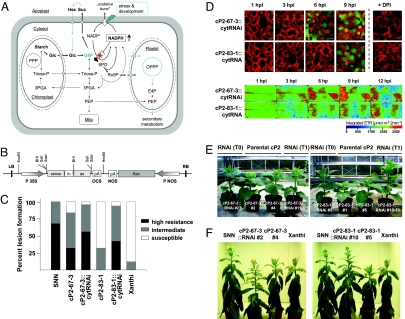Fig. 3.
G6PDH isoenzyme replacement enhances pathogen resistance, abiotic stress tolerance, and development. (A) Schematic representation of the isoenzyme-replacement strategy for elimination of endogenous cytosolic G6PDH activity in the cP2 lines by an RNAi approach. Also depicted are possible benefits for secondary metabolism. Note that NADPH oxidases are activated by transient calcium elevation in the cytosol (41). Hence, NADPH will be consumed only in response to signals (biotic and abiotic cues), which prevents interference with normal physiology and development. PEP, phosphoenolpyruvate; E4P, erythrose 4-phosphate. (B) Expression cassette of the binary cytG6PD-RNAi construct. (C) Disease evaluation of parental cP2 lines versus the corresponding RNAi transformants after pathogen challenge compared with SNN and Xanthi WT. High resistance, 80–100% lesions per area (lpa); intermediate resistance, 35–80% lpa; susceptible response, 0–10% lpa at infiltration site. (D) Representative images of defense-induced ROS release and subsequent changes in dark metabolism. After isoenzyme replacement, descendents of formerly weak line Xan::cP2–83 react much stronger. The same trend was observed for the T1 progeny (compare Fig. S6). For further explanations to A and D, see legends of Fig. 2 and Fig. S5. (E and F) G6PDH isoenzyme replacement revokes growth differences displayed by the parental cP2 lines (E), and enhances abiotic stress tolerance (5 days without watering) (F). Reduced water loss from excised leaf discs further supports enhanced drought tolerance of the cP2 transformants. Average water loss (6 h after detachment, n = 3) was 55% ± 3% for SNN, 67% ± 2% for Xanthi WT, and 50% ± 5% for Xan::cP2-83–1::cytRNAi #10. By feeding abscissic acid (ABA) to excised leaves via the petiole, we excluded that observed drought tolerance is a result of compromised stomatal regulation. Besides ABA-mediated stoma regulation (40), ROS are probably also involved in drought sensing and ABA synthesis (32).

